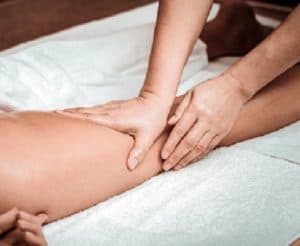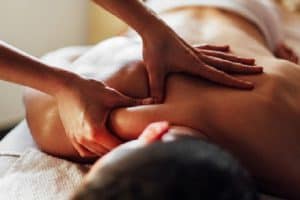
Massage – How Massage Helps Injury Repair
Massage plays an important role in the injury rehabilitation process. Through encouraging circulatory movement and relaxation of the muscles, massage helps the body deliver more oxygen and other important nutrients into the deep tissues and vital organs. This results in an increased rate of rehabilitation and a multitude of other physiological benefits. But we’ll get to those later, for now we’re focusing on injury repair specifically.
Massage is mostly used for acute soft tissue injuries, such as those caused by sudden impact or trauma. These may include sprains, strains, falls, and collision injuries in sport.
Once you receive a soft tissue injury, your body goes through four phases of healing:
- Acute – the first 2-4 days, where you need to rest and apply cold packs to the spot.
- Subacute – up to 6 weeks, and the period where you need to seek treatment from massage therapists.
- Late stage – up to 3 months, where the injury is not fully healed, and it’s very important not to injure yourself again at this point.
- Chronic – if pain still persists after 3 months, the injury is considered chronic. Most injuries do not get this far, but if they do, consider switching up your healing routine and try something new.
With a successful massage therapy, and depending on the type of the injury, you’ll likely never make it past phase two, which just goes to show how effective massages are. Let’s take a closer look and see the physiology of how massage helps injury repair.
The Importance of Massage Therapy in Injury Repair
 After an injury, acute pain can be still felt in the muscles and soft tissues. This pain is caused by muscle tightness and restrictions of the connective tissues. The muscles tighten to protect the injured area and prevent blood flow from reaching the deep tissue. Massage helps to reduce the tightness and restore normal blood circulation in the tissues.
After an injury, acute pain can be still felt in the muscles and soft tissues. This pain is caused by muscle tightness and restrictions of the connective tissues. The muscles tighten to protect the injured area and prevent blood flow from reaching the deep tissue. Massage helps to reduce the tightness and restore normal blood circulation in the tissues.
Another process that happens in your body after an injury is the production of collagen fibres. They are sent to repair the injury, but can’t always reach it due to restrictions in the scar tissue. With proper massage techniques, the scar tissue can be reduced and collagen fibres are realigned, resulting in decreased pain and tightness around the injured area.
When a massage is used to treat an injury, it helps increase the size of the blood vessels by creating friction against the skin and increasing temperature. The larger size allows more blood to flow through the body, transporting more oxygen and nutrients to help repair all the damaged cells.
Besides helping with injury repair, massage therapy is also beneficial for injury prevention. It helps increase tissue elasticity, providing more flexibility and range of movement around the joints. This is especially important for athletes who are consistently training and can have hard and inelastic muscles, resulting in poor efficiency.
As you can see, massage clearly plays an important part in injury repair and healing. But just as there are many types of injuries, there are many different types of massages that are used in combination with one another to produce the best results for each individual. Let’s have a look at the different types of massage.
Massage Therapy Types for Injury Repair
1. Sports Massage
 Sport massages are often used to increase healing on areas of the body containing soft tissues.
Sport massages are often used to increase healing on areas of the body containing soft tissues.
It’s specifically designed for athletes, so they can recover from injuries and improve their performance. It can also be used when there is no injury at all to help relieve the tension of the overused muscles and joints, depending on the individual sport.
Although it was designed for athletes and recovery, a sports massage can be beneficial to anybody who has overworked their muscles and has too much stress built up.
2. Deep Tissue Massage
 A deep tissue massage is a type of massage that focuses on the deeper layers of the muscle and connective tissues. The therapist will use stronger motions and get down into the deeper layers with different techniques and methods, ensuring you are still comfortable.
A deep tissue massage is a type of massage that focuses on the deeper layers of the muscle and connective tissues. The therapist will use stronger motions and get down into the deeper layers with different techniques and methods, ensuring you are still comfortable.
The goal of a deep tissue massage is to reduce pain and stiffness around the injury by realigning the tissues back into their normal form. This massage also physically breaks down the harder areas of tissue called adhesion.
It’s very effective for chronic pain, tight muscles, reducing high muscle tone, and injury repair.
3. Swedish Massage
 A Swedish massage is used to increase healing and encourage relaxation. It uses long and gentle strokes in the direction of blood returning to the heart. It’s the most widely practiced type of massage therapy, and is known as a “classic massage’ in many countries.
A Swedish massage is used to increase healing and encourage relaxation. It uses long and gentle strokes in the direction of blood returning to the heart. It’s the most widely practiced type of massage therapy, and is known as a “classic massage’ in many countries.
It helps reduce tension in the entire body and promote lymphatic drainage, which is the removal of waste products and toxins from the body via stimulation of the lymphatic system. Once all those waste products are removed through the lymphatic flow, the body reduces swelling and works more efficiently, resulting in increased muscle strength and overall improved health.
4. Remedial Massage
Remedial massages are used to locate and repair damaged areas of the body and speed up the healing process. It’s intended as a more targeted treatment for pain, and first starts with a review of the muscles, ligaments, and posture.
Once the massage therapist asks you a few questions and determines the root of the pain, they will perform a targeted deep tissue massage. The pressure applied will vary depending on the specific area.
Since remedial massage is meant for a specific area, it will require more than one session. The therapist will need to constantly reassess the state of the injury and adjust their treatment accordingly.
Conclusion
 Massage can greatly reduce the amount of time required for injury repair, especially for sprains, strains, muscle tears and broken bones. There are many different types of massages, but they all use similar methods and can be combined for the most effective results based on the specific injury.
Massage can greatly reduce the amount of time required for injury repair, especially for sprains, strains, muscle tears and broken bones. There are many different types of massages, but they all use similar methods and can be combined for the most effective results based on the specific injury.
By improving blood flow, increasing tissue elasticity, and removing waste products from the body, massages help the injury heal much faster.








